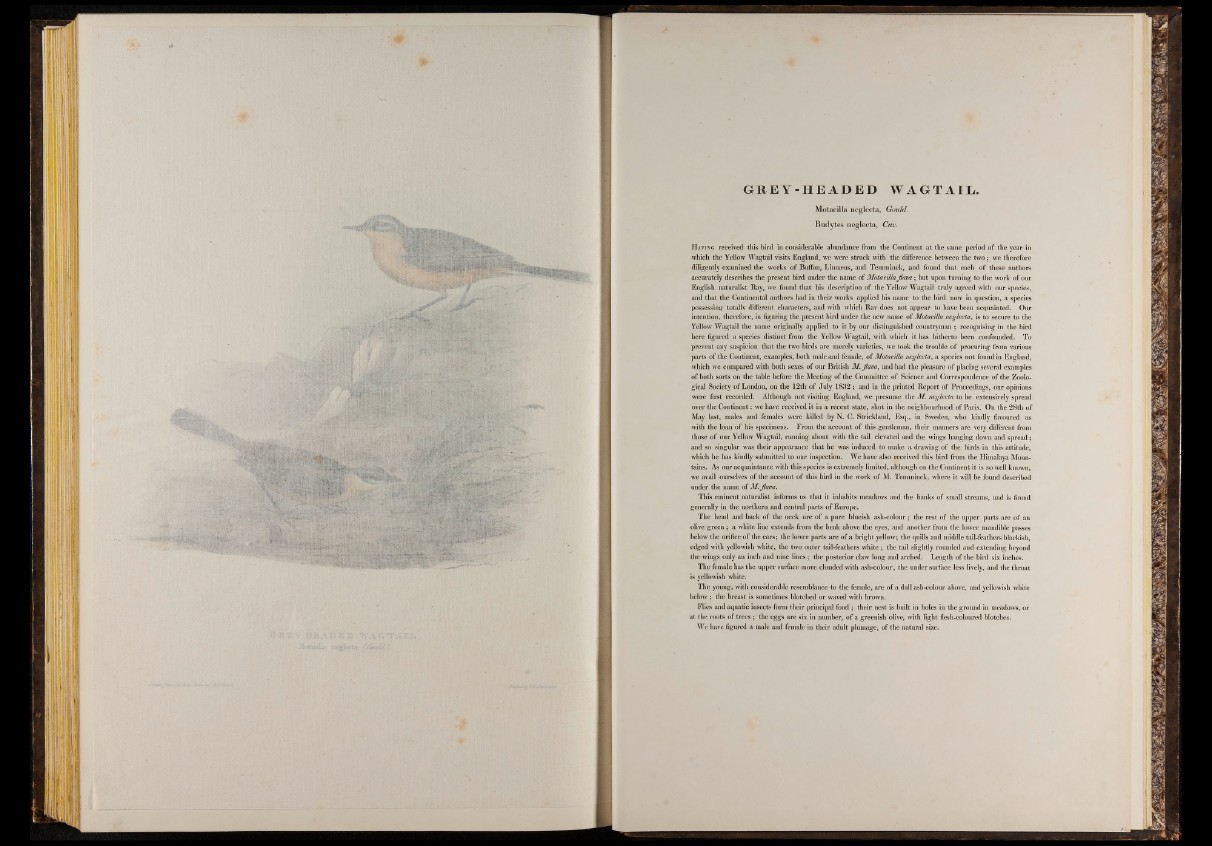
G R E Y -H E A D E D WA G T A I L .
Motacilla neglecta, Gould.
Budytes neglecta, Guv.
H aving received this bird in considerable abundance from the Continent at the same period of the year in
which the Yellow Wagtail visits England, we were struck with the difference between the two ; we therefore
diligently examined the works of Buffon, Linnæus, and Temminck, and found that each of these authors
accurately describes the present bird under the name of Motacilla flava ; but upon turning to the work of our
English naturalist Ray, we found that his description of the Yellow Wagtail truly agreed with our species,
and that the Continental authors had in their works applied his name to the bird now in question, a species
possessing totally different characters, and with which Ray does not appear to have been acquainted. Our
intention, therefore, in figuring the present bird under the new name of Motacilla neglecta, is to secure to the
Yellow Wagtail the name originally applied to it by our distinguished countryman ; recognising in the bird
here figured a species distinct from the Yellow Wagtail, with which it has hitherto been confounded. To
prevent any suspicion that the two birds are merely varieties, we took the trouble of procuring from various
parts of the Continent, examples, both male and female, of Motacilla neglecta, a species not found in England,
which we compared with both sexes of our British M. flava, and had the pleasure of placing several examples
of both sorts on the table before the Meeting of the Committee of Science and Correspondence of the Zoological
Society of London, on the 12th of July 1832 ; and in the printed Report of Proceedings, our opinions
were first recorded. Although not visiting England, we presume the M. neglecta to be extensively spread
over the Continent : we have received it in a recent state, shot in the neighbourhood of Paris. On the 28th of
May last, males and females were killed by N. C. Strickland, Esq., in Sweden, who kindly favoured us
with the loan of his specimens. From the account of this gentleman, their manners are very different from
those of our Yellow Wagtail, running about with the tail elevated and the wings hanging down and spread ;
and so singular was their appearance that he was induced to make a drawing of the birds in this attitude,
which he has kindly submitted to our inspection. We have also received this bird from the Himalaya Mountains.
As our acquaintance with this species is extremely limited, although on the Continent it is so well known,
we avail ourselves of the account of this bird in the work of M. Temminck, where it will be found described
under the name of M. flava.
This eminent naturalist informs us that it inhabits meadows and the banks of small streams, and is found
generally in the northern and central parts of Europe.
The head and back of the neck are of a pure blueish ash-colour ; the rest of the upper parts are of an
olive green ; a white line extends from the beak above the eyes, and another from the lower mandible passes
below the orifice of the ears; the lower parts are of a bright yellow; the quills and middle tail-feathers blackish,
edged with yellowish white, the two outer tail-feathers white ; the tail slightly rounded and extending beyond
the wings only an inch, and nine lines ; the posterior claw long and arched. Length of the bird six inches.
The female has the upper surface more clouded with ash-colour, the under surface less lively, and the throat
is yellowish white.
The young, with considerable resemblance to the female, are of a dull ash-colour above, and yellowish white
below ; the breast is sometimes blotched or waved with brown.
Flies and aquatic insects form their principal food ; their nest is built in holes in the ground in meadows, or
at the roots of trees ; the eggs are six in number, of a greenish olive, with light flesh-coloured blotches.
We have figured a male and female in their adult plumage, of the natural size.